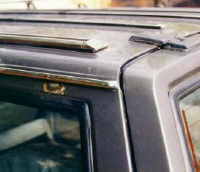|
General Interest #2
Vehicles and Lightning
What happens when lightning strikes a vehicle? The answer, gleaned from
anecdotal observations, is all the way from "nothing" to "Wow!
What a mess. . . my car is a disaster."
Electrically speaking, at lightning's higher frequencies, currents are
carried mostly on the outside of conducting objects. A thick copper wire
or a hollow-wall metal pipe will carry most of the lightning on outer
surfaces. This phenomenon is called Skin Effect. The same holds true for
lightning when it strikes metal vehicles: the outer surface carries most
of the electricity. The persons inside this steel box can be likened to
protected by a partial Faraday Cage.
But, consistent with lightning's capricious nature, situations alter results.
Is the car dry or wet? If the car is made of fiberglass (a poor conductor)
or a convertible, Skin Effect principles may not work. [Corvette and Saturn
owners please note.]
Some general recommendations include:
- Personal Safety Issues: Reported incidents and related injuries make
it clear that a person inside a fully enclosed metal vehicle must not
be touching metallic objects referenced to the outside of the car. Door
and window handles, radio dials, CB microphones, gearshifts, steering
wheels and other inside-to-outside metal objects should be left alone
during close-in lightning events. We suggest pulling off to the side
of the road in a safe manner, turning on the emergency blinkers, turning
off the engine, putting one's hands in one's lap, and waiting out the
storm.
- Heavy Equipment: Backhoes, bulldozers, loaders, graders, scrapers,
mowers, etc. which employ an enclosed rollover systems canopy (ROPS)
are safe in nearby electrical storms. The operator should shut down
the equipment, close the doors, and sit with hands in lap, waiting out
the storm. In no circumstances, during close-in lightning, should the
operator attempt to step off the equipment to ground in an attempt to
find another shelter. Very dangerous Step Voltage and Touch Voltage
situations are created when a "dual pathway to ground" is
created. Lightning voltages will attempt to equalize themselves, and
they may go through a person in order to do so.
Smaller equipment without ROPS is not safe. Small riding mowers, golf
cars, utility wagons are examples. Rubber tires provide zero safety
from lightning. After all, lightning has traveled for miles through
the sky: four or five inches of rubber is no insulation whatsoever.
People should safely abandon this machinery and get into a safe shelter.
- School buses. Metal buses are good Faraday Cages. Make sure all windows
are closed and the "hands on laps" rule is observed. Pull
over and wait out the storm.
- Damage. Reported damage to vehicles includes pitting, arcing, burning
on both exterior and interior places. See the below photographs, courtesy
of Mr. Brown, of his Jeep Cherokee which was struck by lightning. Cases
have been reported of total destruction of vehicle wiring, and associated
electrical and electronic systems. Cases from police departments report
bad burns to the hands and mouth where officers were using radio microphones
when their vehicles were struck. Cases describe total blow-out of all
four tires in passenger cars. A video in our NLSI library shows a station
wagon being struck by lightning in a heavy rain storm, with no damage
whatsoever occurring.
|
Strike near hatchback 
|
close-up or strike 
|
strike at roof
|
roof strike closer to front |
close-up
 |
|
strike on wheel

|
close-up strike near axel

|
|
![]()